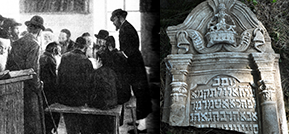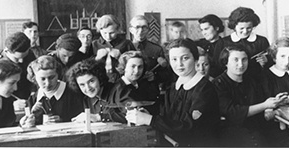With the outbreak of World War II, Nadworna was occupied by the Soviet Army on September 20, 1939 (Pinkas Hakehilot, 330). However, in the first days of the Soviet invasion there were no authorities in Nadworna. Young Jews organized self-defense units, which patrolled the streets and even helped the Jews in Solotwin to stop the plundering of houses and shops by local Ukrainian peasants (Israel Carmi, "Tahat ha-kibush ha-sovieti," Sefer Nadvurna, 150).
With the Soviet consolidation of power, the activity of the Jewish community and of all Jewish political organizations was prohibited.
After the attack of the German army on the Soviet Union, Nadworna was occupied by Hungarian troops on July 1, 1941 (Pinkas Hakehilot, 330). Several representatives of Nadworna Jewry turned to the Hungarian military authorities in order to prevent attacks by the local Ukrainian population on Jews. Despite these efforts, a pogrom took place in mid-July 1941, and dozens of Jews were killed (Pinkas Hakehilot, 330). Ukrainian nationalists accused Jews of cooperating with the Soviets and of participating in the mass killings of Ukrainian prisoners in the forests around the town.
In September 1941, Nadworna passed over to the German occupation zone (Pinkas Hakehilot, 330). Nadworna Jews were ordered to wear white bandages with the Star of David and to supply individuals for forced labor. The head of the Nadworna Jewish Council (Judenrat) was Dr. Maximilian Schal and his deputy was Yitzhak Schapira (Pinkas Hakehilot, 330).
The first "action" took place on October 6, 1941. More then 2,000 Jews were collected by the local Ukrainian police and brutally murdered in the Bukovinka forest next to the town. Jews from the Nadworna region and Jewish refugees from the Carpato-Rus area that were expelled to Nadworna by Hungarians just a month before the "action" were also among those who perished in the Bukovinka forest (Pinkas Hakehilot, 330).
Two ghettos were established in Nadworna in the spring of 1942: one for those who were able to work in forced labor brigades and another one for those who were not capable of working. Jews were forbidden to move between the ghettos after April 30, 1942 (Pinkas Hakehilot, 330). Living conditions were horrible in both ghettos but residents of the second one were the immediate target for extermination.
In August 1942, Dr. Maximilian Schal and members of Judenrat were arrested and taken to the Gestapo Office in Stanislawow where they were tortured and accused of issuing permits to Jews to work outside of Nadworna. They returned to the town but the Jews were forced to pay a contribution of 25,000 złoty (it grew to 28,000 złoty) to secure their release (Pinkas Hakehilot, 331).
Most of the Jews of Nadworna and the region were murdered in the "actions" of the fall of 1942. Some of them were sent to Stanislawow where they were murdered later with Jews from other places (Pinkas Hakehilot, 331).
Nadworna was liberated by the Soviet Army on July 26, 1944. Only handful of Nadworna Jews survived the Holocaust (Pinkas Hakehilot, 331).
Further reading: Nadworna - after WWII






